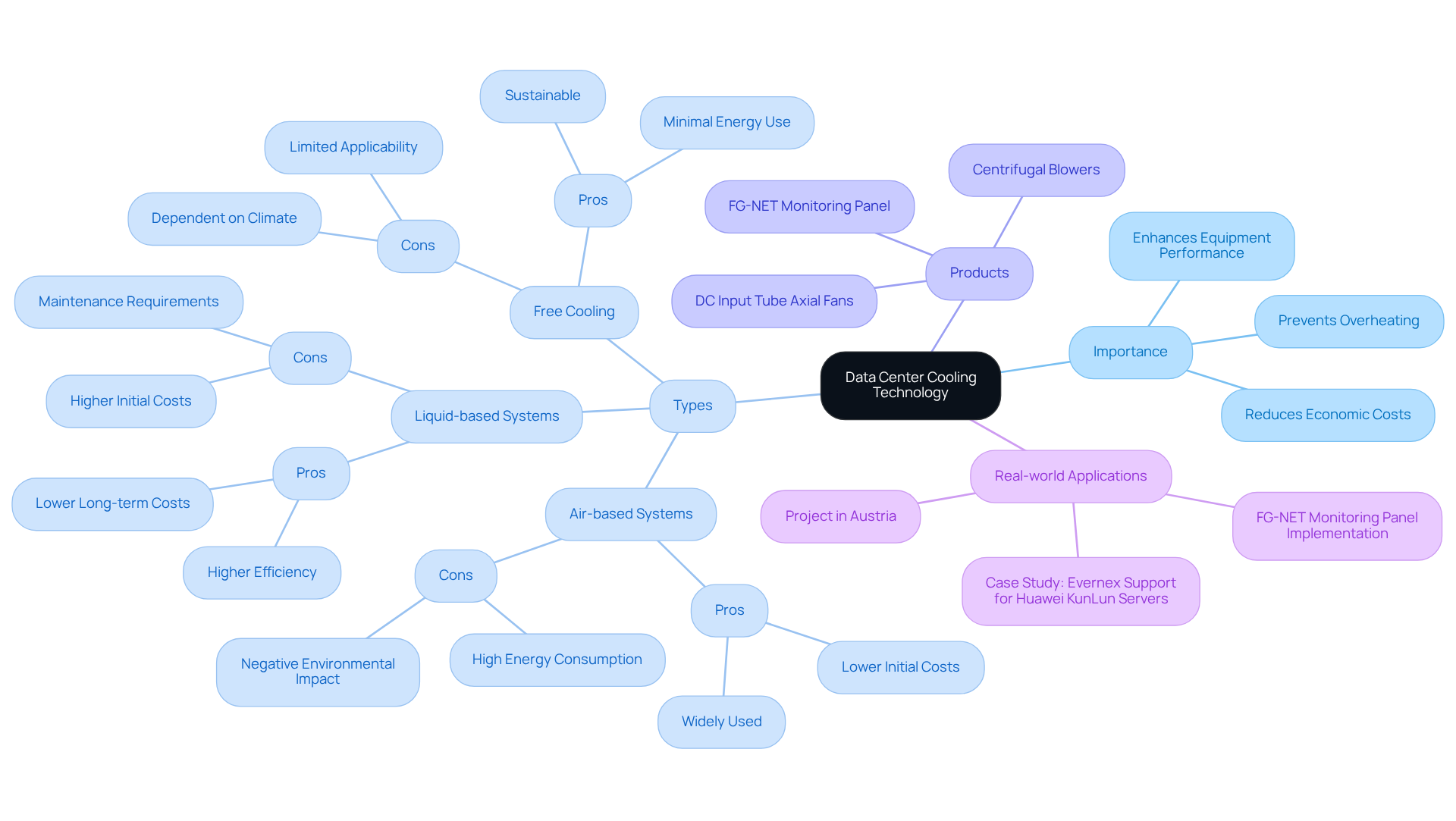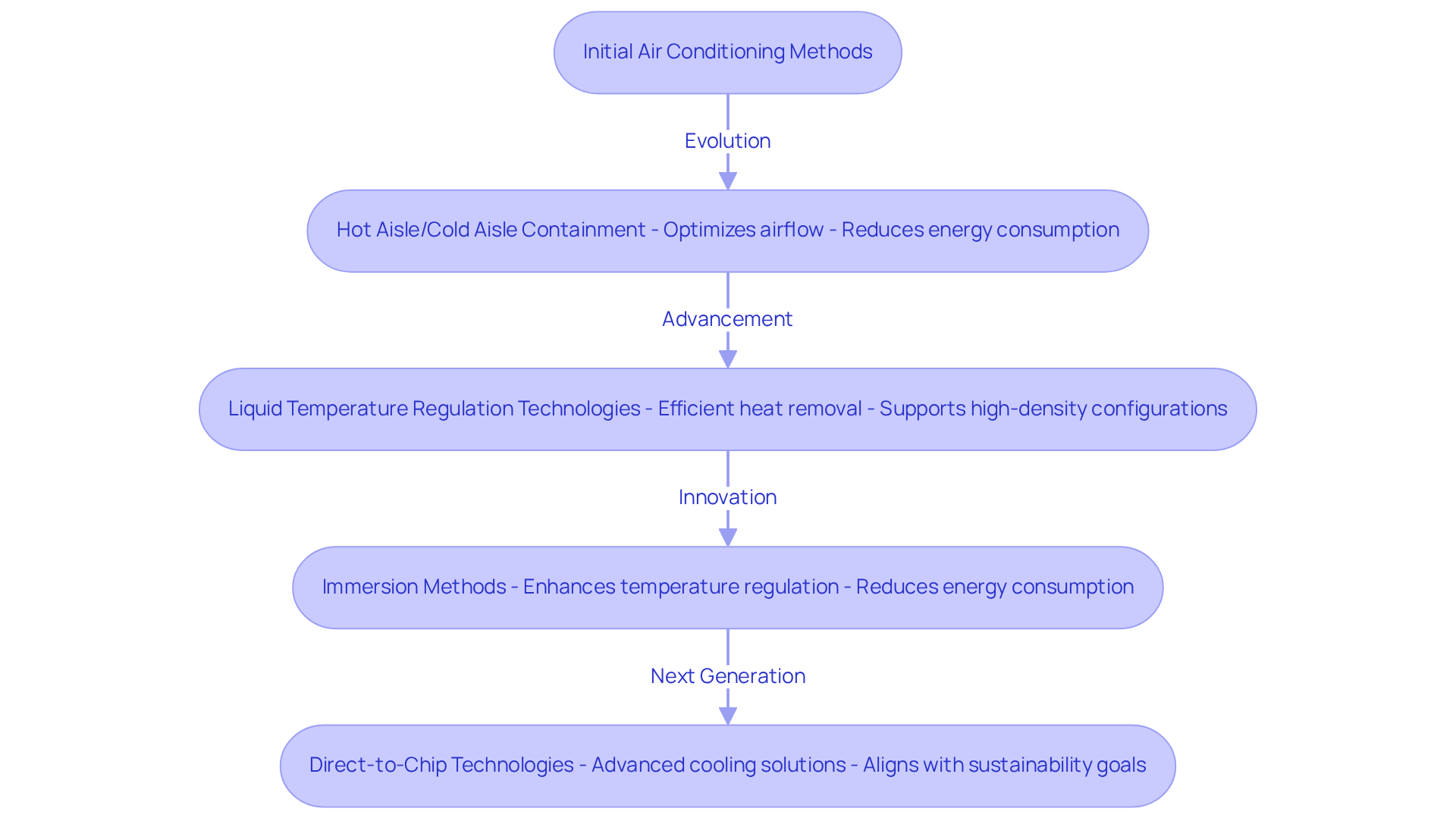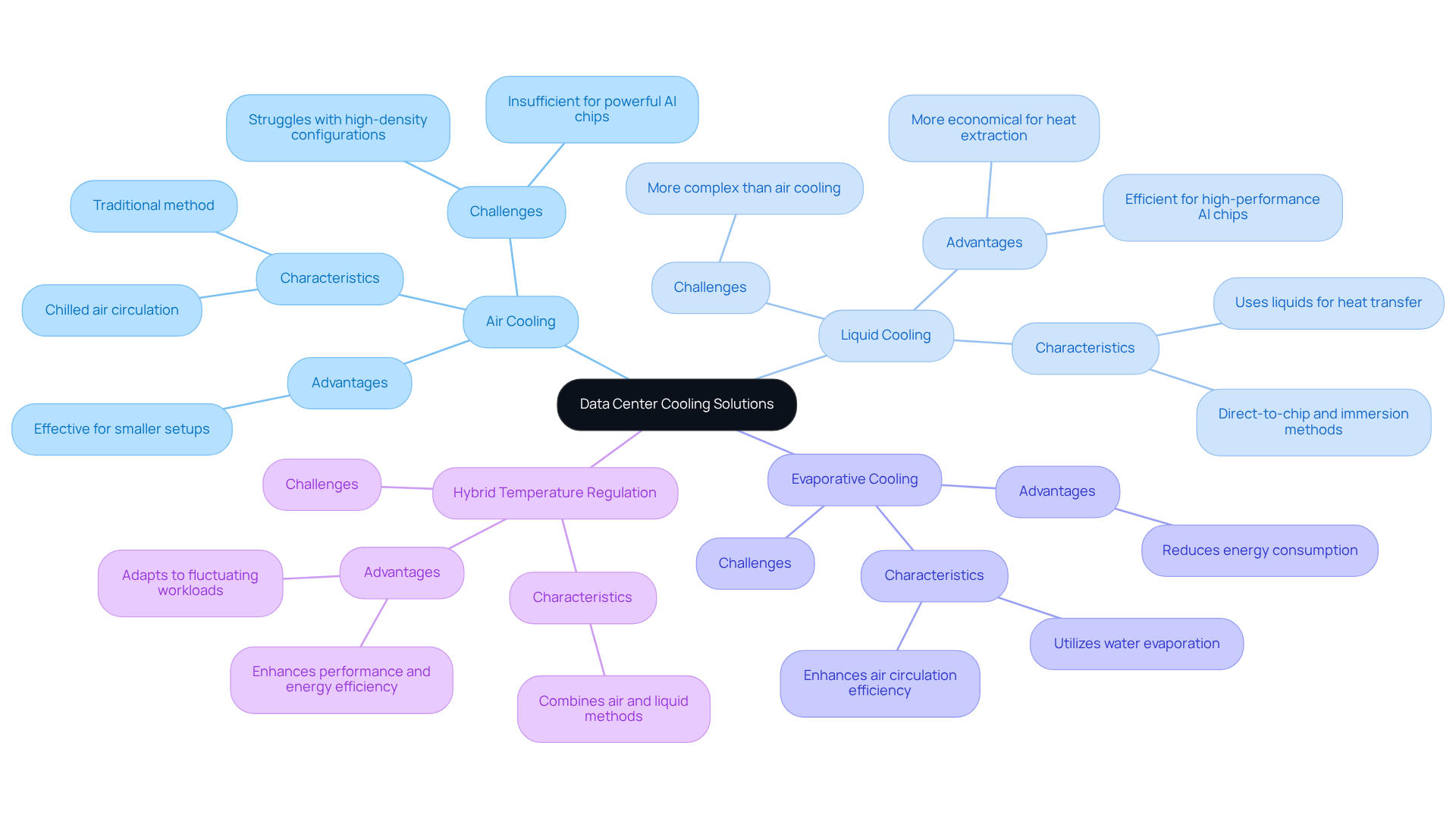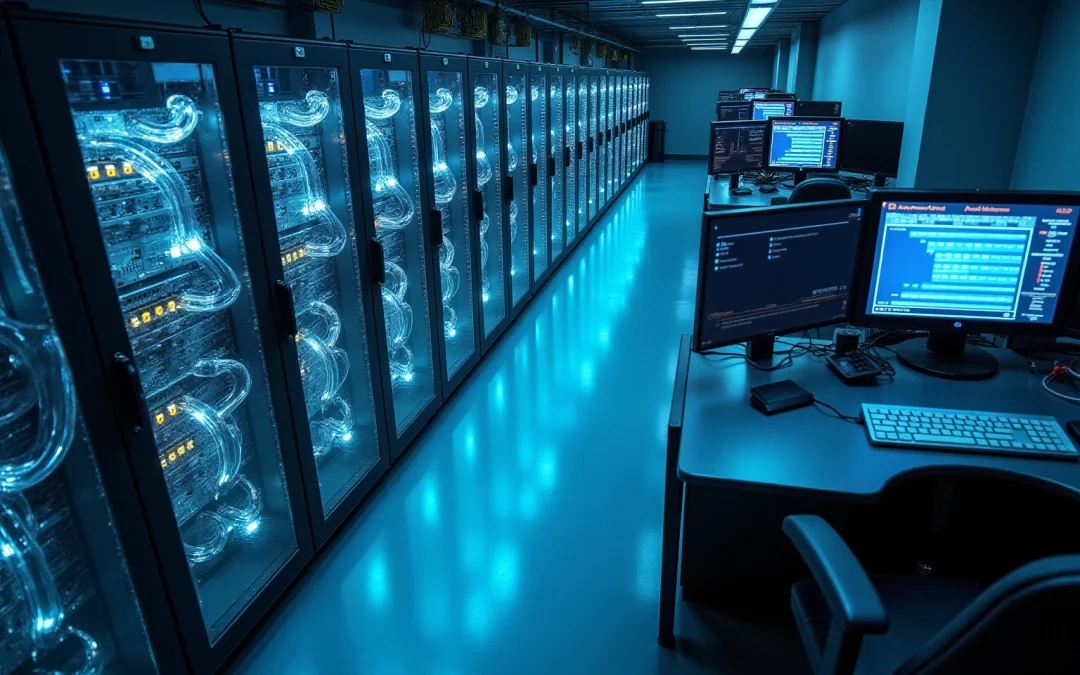Overview
This article examines the evolution and solutions of data center cooling technology, underscoring its vital role in sustaining optimal temperatures for IT equipment. It details the advancements from traditional air cooling methods to cutting-edge liquid cooling technologies, illustrating how these innovations enhance energy efficiency and mitigate environmental impacts. These developments are crucial in addressing the escalating demands of high-performance computing, making it imperative for stakeholders to adapt and implement these solutions.
Introduction
The rapid expansion of digital infrastructure has imposed unprecedented demands on data centers, rendering effective temperature regulation more critical than ever. As these facilities advance, a comprehensive understanding of the diverse cooling technologies—spanning from traditional air conditioning to cutting-edge liquid cooling methods—becomes essential for optimizing performance and minimizing energy consumption. Yet, with a plethora of options available, how can facility operators adeptly navigate the complexities of cooling solutions to ensure sustainability and efficiency in an ever-evolving landscape?
Define Data Center Cooling Technology
Temperature regulation technology encompasses the strategies and methodologies designed to maintain optimal temperature and humidity levels within facilities, which is vital for the reliable operation of IT equipment. Given that data centers house numerous servers and networking devices that generate substantial heat, effective data center cooling technology is essential for temperature regulation to prevent overheating, which can lead to equipment failure and diminished performance.
Gagner-Toomey Associates, recognized as the world’s largest manufacturer of both standard and custom air-movers, provides an extensive product range of DC input tube axial fans and centrifugal blowers, engineered for performance, efficiency, and low noise. These attributes render them particularly well-suited for electronics and automotive applications.
Data center cooling technology is primarily classified into air-based and liquid-based systems, each utilizing distinct mechanisms for heat dissipation and energy efficiency. For example, traditional air conditioning, while prevalent due to its lower initial costs, presents significant environmental concerns, including elevated energy consumption and adverse effects on local microclimates. Conversely, innovative methods such as liquid temperature regulation and free temperature management in data center cooling technology offer enhanced efficiency and sustainability, albeit potentially requiring greater initial investments.
Real-world implementations, such as the FG-NET monitoring panel, exemplify the effectiveness of advanced temperature regulation solutions by accurately detecting leaks and integrating with Building Management Systems (BMS) to optimize temperature control operations. Understanding data center cooling technology is crucial for facility operators who aim to enhance performance while minimizing energy consumption and ecological impact.

Trace the Evolution of Cooling Technologies
The evolution of data center cooling technology has been profoundly influenced by the demand for enhanced efficiency and reliability. Initially, these systems relied on basic air conditioning methods, which struggled to manage the increasing heat loads generated by modern servers. As facilities expanded, innovations such as hot aisle/cold aisle containment became prevalent, optimizing airflow and reducing energy consumption. By 2023, approximately 30% of facilities had adopted this containment strategy, underscoring its effectiveness in improving temperature regulation.
The advent of liquid temperature regulation technologies in the 2000s represented a significant transformation in the industry, facilitating more efficient heat removal and accommodating higher-density configurations. A prime example is the OTTO platform, a commercial-grade two-phase liquid immersion temperature regulation solution, which supports extreme high-density computing blades consuming up to 6,000 watts each. This system achieves a power flux of 3,750 watts per square foot—vastly exceeding the 150-200 watts per square foot typical of conventional air-cooled facilities.
Currently, cutting-edge solutions such as immersion methods and direct-to-chip technologies are gaining momentum, reflecting the industry’s steadfast commitment to sustainability and efficiency. These advancements not only enhance temperature regulation but also contribute to reduced energy consumption, aligning with global initiatives aimed at diminishing the ecological footprint of information facilities. Notably, infrastructure systems such as refrigeration and power overhead accounted for 40% of information facility energy consumption in 2014, decreasing to 30% by 2023, illustrating the progress in energy efficiency over time.
As the market continues to grow, projected to reach $1 trillion by 2027, the development of data center cooling technology will remain a critical focus for operators striving to meet the demands of high-performance computing while ensuring operational reliability. Furthermore, the hyperscale facility market in Asia is expected to expand from $4.8 billion to $10 billion between 2020 and 2027, highlighting broader market dynamics. Looking ahead, addressing the environmental impacts of data facilities is imperative, with forecasts indicating that by 2030, global data facility carbon dioxide emissions are anticipated to rise to approximately 2.5 billion metric tons.

Explore Types of Data Center Cooling Solutions
Data center cooling technology solutions can be classified into various types, each designed to address specific temperature control challenges. Common methods include:
-
Air Cooling: This traditional method employs chilled air circulated through ducts to remove heat. While effective for smaller setups, it may struggle with high-density configurations, particularly as the demand for temperature regulation intensifies with the rise of powerful AI chips that generate substantial heat. Air-based systems have been utilized for temperature regulation in AWS’s facilities thus far, yet the limitations of this approach have become increasingly apparent as these facilities evolve.
-
Liquid Cooling: Utilizing liquids as a heat transfer medium, this method can absorb and dissipate heat more efficiently than air. Variants include direct-to-chip temperature regulation and immersion methods, which submerge components in non-conductive liquids. Liquid temperature regulation as a form of data center cooling technology has emerged as a more economical solution for heat extraction, surpassing air methods. AWS’s bespoke liquid temperature management solution, developed in just 11 months, exemplifies the efficiency of liquid methods in managing the heat generated by high-performance AI chips without increasing water usage. Klusas emphasizes that this arrangement is designed to be energy and cost-efficient, adapting to meet customer needs. He stated, “We created our liquid temperature regulation setups to facilitate their integration into data centers where they’re required, while preventing the cost of incorporating them where they’re unnecessary.”
-
Evaporative Cooling: This method leverages the chilling effect of water evaporation, frequently employed alongside air circulation mechanisms to enhance efficiency. It utilizes natural processes to reduce energy consumption while ensuring effective temperature regulation.
-
Hybrid Temperature Regulation: By merging air and liquid temperature management techniques, hybrid approaches aim to enhance performance and energy efficiency, dynamically adjusting to fluctuating workloads. These systems can adapt to provide a versatile solution for information hub operators.
Each temperature regulation solution in data center cooling technology presents distinct advantages and challenges, making it essential for center operators to evaluate their specific needs and operational objectives when selecting a temperature management strategy. Furthermore, AWS’s reverse logistics program offers a sustainable pathway for components while upholding high data security, further underscoring the significance of sustainability in cooling solutions.

Conclusion
The landscape of data center cooling technology has undergone significant transformation, reflecting the pressing need for efficient temperature management in increasingly complex IT environments. This evolution highlights the critical role that innovative cooling solutions play in maintaining optimal operational conditions, thus safeguarding the performance and longevity of essential equipment.
Throughout the article, the progression from traditional air conditioning to advanced liquid cooling methods underscores the industry’s shift towards sustainability and energy efficiency. Key developments, such as hot aisle/cold aisle containment and liquid immersion technologies, have demonstrated their effectiveness in addressing the challenges posed by high-density computing. Additionally, the exploration of various cooling methods—ranging from air and liquid cooling to hybrid solutions—illustrates the diverse strategies available to data center operators in their quest for optimal temperature regulation.
As the demand for data processing continues to surge, the importance of implementing effective cooling technologies cannot be overstated. Facility operators are urged to consider the environmental impact and energy consumption of their cooling strategies, aligning with global sustainability goals. Embracing these advancements not only enhances operational efficiency but also contributes to a greener future for data centers, paving the way for continued innovation in this vital sector.
Frequently Asked Questions
What is data center cooling technology?
Data center cooling technology refers to the strategies and methodologies used to maintain optimal temperature and humidity levels in facilities, which is essential for the reliable operation of IT equipment.
Why is effective cooling important in data centers?
Effective cooling is crucial in data centers because numerous servers and networking devices generate significant heat. Proper temperature regulation prevents overheating, which can lead to equipment failure and reduced performance.
What types of cooling systems are used in data centers?
Data center cooling systems are primarily classified into air-based and liquid-based systems, each employing different mechanisms for heat dissipation and energy efficiency.
What are the advantages and disadvantages of air conditioning in data centers?
Air conditioning is commonly used due to its lower initial costs, but it poses environmental concerns, such as high energy consumption and negative impacts on local microclimates.
What are some innovative cooling methods in data centers?
Innovative cooling methods include liquid temperature regulation and free temperature management, which offer enhanced efficiency and sustainability but may require higher initial investments.
How can advanced monitoring solutions improve data center cooling?
Advanced monitoring solutions, like the FG-NET monitoring panel, can accurately detect leaks and integrate with Building Management Systems (BMS) to optimize temperature control operations.
Why should facility operators understand data center cooling technology?
Understanding data center cooling technology is vital for facility operators to enhance performance while minimizing energy consumption and reducing ecological impact.

